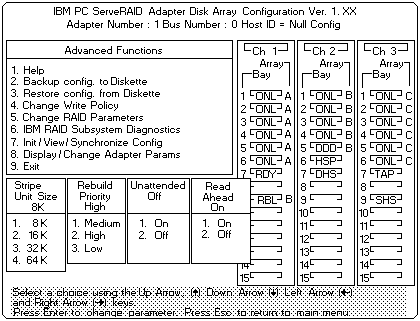|
|

The default settings are:
 Once the stripe unit is chosen and data is stored in the
logical drives, the stripe unit cannot be changed
without destroying data in the logical drives.
Once the stripe unit is chosen and data is stored in the
logical drives, the stripe unit cannot be changed
without destroying data in the logical drives.
The stripe unit size is the amount of data written on a given disk before writing on the next disk. To maximize the overall performance, choose the stripe unit such that the stripe-unit size is close to the size of the system I/O request. The default is set to 8K data bytes.
Note: When the stripe unit is 8K or 16K, the max. number of drives in an array is 16. When the stripe unit size is 32K or 64K, the max. number of drives in an array is 8.
Rebuild priority can be set to high, medium, or low. When the rebuild request is set to high, the rebuild I/O request and system I/O request get high priority in the execution order.
When the rebuild request is set to medium, in a heavily loaded system (with a medium rate of system I/O requests), the medium-priority rebuild can reduce the disk rebuild time at the expense of degraded handling of I/O requests.
When the rebuild priority is set to low, in a moderate to heavily loaded system, low rebuild priority will increases the disk rebuild time but provides better system performance.
Note: Rebuild priority can be changed without affecting data in the logical drives.
You can enable the adapter to accept changes in the configuration without user input. Unattended mode is useful when the server operates remotely. See 'Unattended Mode of Operation'.
when Unattended Mode is On, and a hard disk drive is found in a location other than the one defined in the adapter configuration, the program pauses briefly for user input, then, automatically rearranges the configuration information to correct the logical drive configuration. Unattended mode also clears any blocked devices.
When Unattended Mode is Off, the program waits for user input.
Normally, the ServeRAID adapter transfers data from disk to its local cache in steps of stripe-unit size. This provides excellent overall performance when workloads tend to be sequential. However, if the workload is random and system I/O requests are smaller than stripe-unit size, reading ahead to the end of the stripe unit will result in wasted SCSI bus bandwith and wasted disk utilization. When read-ahead is set to Off, the size of data transfer from the disk to local cache is equal to the system I/O request size, and no read-ahead to the end of the stripe unit is performed.
Please see the LEGAL - Trademark notice.
Feel free - send a  for any BUG on this page found - Thank you.
for any BUG on this page found - Thank you.